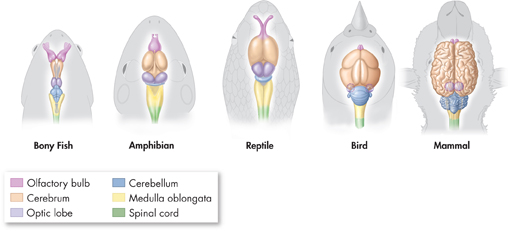
FIGURE 28–4 Vertebrate Brains The cerebrum and cerebellum increase in size from fishes to mammals. In fishes, amphibians, and reptiles, the cerebrum, or “thinking“ region, is relatively small. In birds and mammals, and especially in primates, the cerebrum is much larger and may contain folds that increase its surface area. The cerebellum is also most highly developed in birds and mammals.
ddChordates Nonvertebrate chordates, which have no vertebrate-type “head” as adults, still have a cerebral ganglion. Vertebrates, on the other hand, show a high degree of cephalization and have highly developed nervous systems. Vertebrate brains are formed from many interneurons within the skull. These interneurons are connected with each other and with sensory neurons and motor neurons in the head and elsewhere in the body. The human brain contains more than 100 billion nerve cells, each of which sends signals to as many as 1000 other nerve cells and receives signals from up to 10,000 more.
▸ Parts of the Vertebrate Brain Regions of the vertebrate brain include the cerebrum, cerebellum, medulla oblongata, optic lobes, and olfactory bulbs. The cerebrum is the “thinking” region of the brain. It receives and interprets sensory information and determines a response. The cerebrum is also involved in learning, memory, and conscious thought. The cerebellum coordinates movement and controls balance, while the medulla oblongata controls the functioning of many internal organs. Optic lobes are involved in vision, and olfactory bulbs are involved in the sense of smell. Vertebrate brains are connected to the rest of the body by a thick collection of nerves called a spinal cord, which runs through a tube in the vertebral column.

FIGURE 28–5 Not Such a Bird Brain The brains of some chickadee species are so sophisticated that the part responsible for remembering locations gets bigger when the bird stores food in the fall. When winter comes, the tiny bird is better able to find its hundreds of storage places. (In spring, its brain returns to normal size.) Infer Which of the six main parts of the chickadee brain would you expect to grow in the fall?
▸ Vertebrate Brain Evolution Brain evolution in vertebrates follows a general trend of increasing size and complexity from fishes, through amphibians and reptiles, to birds and mammals. Figure 28–4 shows how the size and complexity of the cerebrum and cerebellum increase.
 In Your Notebook Construct a figure of speech that explains, in terms of another object, how the folds of the mammalian cerebellum increase its surface area.
In Your Notebook Construct a figure of speech that explains, in terms of another object, how the folds of the mammalian cerebellum increase its surface area.
Table of Contents
- Formulas and Equations
- Applying Formulas and Equations
- Mean, Median, and Mode
- Estimation
- Using Measurements in Calculations
- Effects of Measurement Errors
- Accuracy
- Precision
- Comparing Accuracy and Precision
- Significant Figures
- Calculating With Significant Figures
- Scientific Notation
- Calculating With Scientific Notation
- Dimensional Analysis
- Applying Dimensional Analysis




